![]()
![]()
![]()
Use LEFT and RIGHT arrow keys to navigate between flashcards;
Use UP and DOWN arrow keys to flip the card;
H to show hint;
A reads text to speech;
68 Cards in this Set
- Front
- Back
|
Describe the traditional reconstructive ladder
|
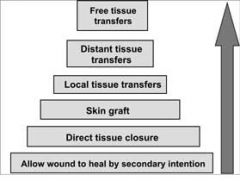
Complexity increases as you go up the ladder
The surgeon is to choose the technique(s) that is most expedient for addressing the reconstructive problem with contingency plans in case of flap/graft failure or recurrence. |
|
|
Split Thickness Skin Grafts
Where are they typically harvested from? |
Thigh or buttocks, using a powered dermatome
|
|
|
Split Thickness Skin Grafts
What is the typical thickness of this graft? |
Varies from 0.012 - 0.016 inches
Thinner grafts exhibit more reliable neovascularization, but more contracture than thicker grafts |
|
|
Split Thickness Skin Grafts
What is the donor site covered with? |
pourous dressing or occlusive semipermeable dressing for 1 week
|
|
|
Split Thickness Skin Grafts
What are the disadvantages to this type of graft? |
Poor color match, texture and possible contracture
|
|
|
Split Thickness Skin Grafts
List some applications for this type of graft |
1) Small defects of oral cavity
2) Maxillectomy cheek flap defect (internal lining) 3) Temporalis fascia flap cover for auricular and periorbital reconstruction 4) Auricular reconstruction 5) Coverage of free flap donor sites 6) Meshed grafts may be used to cover large defects in the scalp, but are cosmetically unacceptable in other facial areas |
|
|
Full Thickness Skin Grafts
List the donor sites |
Postauricular
Upper eyelid Supraclavicular Preauricular Nasolabial areas |
|
|
Full Thickness Skin Grafts
Where is this typically used? |
Appropriate for small (1-5cm), externally visible facial defects
- graft is defatted, and donor site is closed primarily |
|
|
Cartilage Grafts - Septal Cartilage Graft
About how much do you have to leave caudally and dorsally (struts) when harvesting septal cartilage in order to maintain support of the nasal dorsum and tip? |
1.5cm
|
|
|
Cartilage Grafts - Septal Cartilage Graft
What are the applications? |
Used primarily for nasal dorsal and tip minor support, and augmentation in the form of onlay grafts, alar batten grafts, columellar strut grafts, spreader grafts, and tip grafts.
Small orbital floor defect reconstruction Reconstruction of eyelid lacerations involving the lid margin and tarsal plate |
|
|
Cartilage Grafts - Auricular Cartilage Graft
What are the applications? |
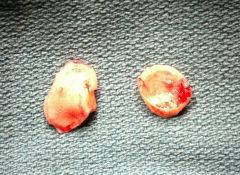
Typically harvested from the conchal bowel with no cosmetic deficit
Inidications are similar to those for septal cartilage grafts (nose, orbital floor, eyelid) Also used for reconstruction of large nasal alar and septal cartilage defects |
|
|
Cartilage Grafts - Costal Cartilage Graft
Which ribs are typically used? |
Straight segments of the 6th, 7th and 8th ribs are used for large nasal dorsal reconstruction defects (ie. saddle nose deformities)
Curved and straight segments of the 6th-8th ribs are used for auricular reconstruction Rib cartilage is also used for laryngotracheal reconstruction |
|
|
What limits the size and thickness of free bone grafts?
|
All free bone grafts are nonliving scaffolds which are replaced by mesenchymal cells that differentiate into osteoblasts. Size and thickness is limited due to need for vascular invasion. Resorption is also a common problem, so must rigidly immobilize the bone graft.
|
|
|
Bone Grafts - Cortical Free Bone Grafts
What are the harvest sites? |

Split calvarium
Split rib Iliac crest |
|
|
Bone Grafts - Cortical Free Bone Grafts
What are the applications? |
Nasal dorsal augmentation
Malar and chin augmentation Posttraumatic reconstruction of facial buttresses Prevention of relapse in orthognathic surgery Prevention of relapse and filling of defects in correction of craniosenostoses |
|
|
Bone Grafts - Cancellous Bone Grafts
What are the harvest sites? - what are some advantages of this graft compared to cortical free bone grafts. |
Iliac crest
Tibia More quickly vascularized than cortical bone BUT have no structural integrity, so cannot be used for load-bearing |
|
|
Bone Grafts - Cancellous Free Bone Grafts
What are the applications? |
Repair of mandibular nonunion and small segmental mandibular defects up to 5cm with a bone cage.
Alveolar bone grafting in cleft lip and palate Sinus obliteration Repair of small cranial contour defects |
|
|
What are the common donor sites for nerve interposition grafts?
|
Greater auricular nerve
Medial antebrachial cutaneous nerve Radial nerve Sural nerve |
|
|
What is a composite graft and what are the common applications?
What are the donor sites? |
A composite graft is a small graft containing skin and underlying cartilage or other tissue.
Donor sites are routinely harvested from the conchal bowl, and are used to reconstruct defects of the nasal ala and columella |
|
|
What kind of blood supply pattern is provided to local flaps?
|
Subdermal plexuses (do not have a dominant vascular supply)
|
|
|
What are advantages to local flaps?
|
superior color match and texture to skin grafts
|
|
|
Skin is anisotropic. What does that mean?
|
Means that the skins mechanical properties vary with direction.
|
|
|
What are relaxed skin tension lines and lines of maximal skin tension?
|
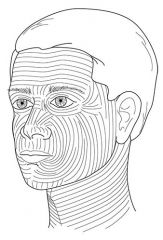
Relaxed skin tension lines (RSTL's) are lines of minimal tension (image)
Lines of maximal skin tension are PERPENDICULAR to RSTL's. |
|
|
What is the traditional length-to-width ratio of a local flap to ensure adequate flap perfusion?
|
3:1 length:width ratio...so the base of the flap (width) should be at least a 1/3 of the size of the flap length
|
|
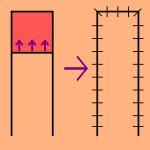
What's the name of this local flap?
|
Advancement flap
|
|
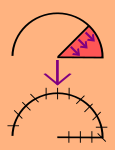
What's the name of this local flap?
|
Rotation flap
|
|
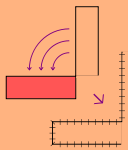
What's the name of this local flap?
|
Transposition flap
|
|
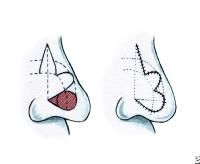
What's the name of this local flap?
|
Bilobed (interposition) flap
|
|
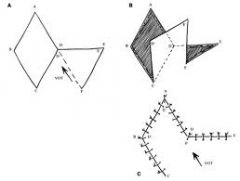
What's the name of this local flap?
|
Rhombic (interposition) flap
|
|
|
What are the applications of local flaps?
|
Defects of the facial skin and scalp
Nasolabial interpolation flaps may be used for small defects of the buccal mucosa and floor of mouth Nasolabial flaps, nasal dorsal flaps, septal mucosal flaps, and inferior turbinate mucosal flaps may be used for internal lining of nasal defects. Buccal mucosal flaps may be used for repair of intranasal defects |
|
|
What is a regional flap?
|
These flaps have an axial pattern based on one or more dominant vessels
Flap design is based on the concept of angiosomes. - An angiosome is the tissue volume supplied by a single source artery and vein - "choke" or oscillating arteries connect adjacent angiosomes - An adjacent agiosome may be captured in flap design by interrupting the adjacent source artery due to reversal of physiologic flow (flap training). - The risk of partial flap necrosis is significantly greater when the design extends beyound the adjacent angiosome. |
|
|
Regional Flaps - Paramedian Forehead Flap
What is the application for this flap? |
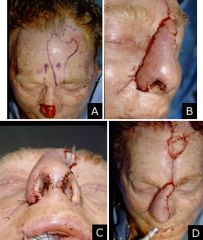
Nasal defects
Upper lip Medial cheek skin defects |
|
|
Regional Flaps - Paramedian Forehead Flap
Which artery is the flap based on? |
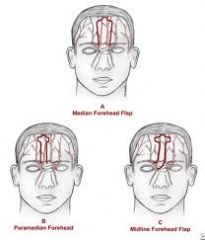
Supratrochlear artery
|
|
|
Regional Flaps - Temporalis Fascia Flap
What are the applications for this flap? |

Primarily used as vascularized tissue bed for split thickness skin grafts used in auricular, forehead and periorbital reconstruction.
|
|
|
Regional Flaps - Temporalis Fascia Flap
Which artery is the flap based on? |
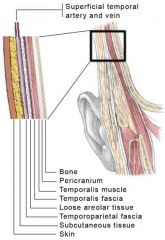
Superficial temporal artery
The temporal fascias (superficial, temporoparietal, and deep) may be transferred as single or bilobed flaps based on branches of the superficial temporal artery. |
|
|
Regional Flaps - Deltopectoral Flap
What are the applications for this flap? |
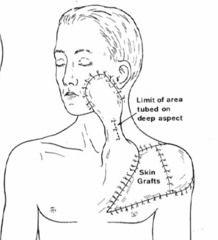
Largely of historic interest
Applications include central neck cutaneous reconstruction, staged pharyngoesophageal reconstruction, and cheek reconstruction |
|
|
Regional Flaps - Deltopectoral Flap
Which artery is the flap based on? |
Based on perforators of the internal mammary artery in the first two intercostal spaces
|
|
|
Regional Flaps - Palatal Island Flap
What are the applications for this flap? |
Use for defects of the central palate, or defects of the central palate including the maxillary alveolus posterior to but not including the canine teeth.
|
|
|
Regional Flaps - Palatal Island Flap
Which artery is the flap based on? |
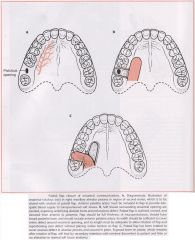
Greater palatine artery
|
|
|
Regional Flaps - Temporalis Muscle Flap
What are the applications for this flap? |
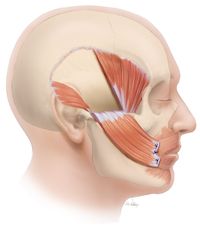
Historically used for facial reanimation, primarily in the lower face
|
|
|
Regional Flaps - Temporalis Muscle Flap
Which artery is the flap based on? |
Muscular flap based on the deep temporal artery
|
|
|
Regional Flaps - Pectoralis Major Flap
What are the applications for this flap? |
Workhorse flap secondary to ease of dissection and versatility.
Many applications, including: 1) flap can reach as superiorly as the hard palate and superior helix. It is suitable for reconstruction of facial, oral, and pharyngeal defects below this level. 2) To avoid transfer of hair-bearing tissue into the mouth, the muscle with its overlying fascia may be transferred into an oral defect and then skin grafted 3) The muscle with its overlying fascia may be transferred into the neck without the skin paddle to provide coverage of the ipsilateral carotid artery 4) The flap may be tubed on itself for pharyngoesophageal reconstruction Transposition of the flap is limited by the arc of rotation of the flap pedicle over the clavicle. With superiorly located defects, removal of a segment of the clavicle may increase the reach of the flap. |
|
|
Regional Flaps - Pectoralis Major Flap
Which artery is the flap based on? |
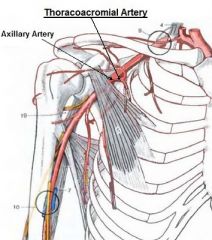
Based on the pectoral branch of the thoracoacromial artery
|
|
|
Regional Flaps - Pectoralis Major Flap
What are the disadvantages this flap? |
Inferiorly pedicle flaps exhibit a tendency toward dehiscence, the more superior the defect due to gravity, and the bulk of the flap, which is greater in women.
The most distal aspect of the skin paddle, which is the most poorly perfused, is necessarily inset into the most superior aspect of the defect. |
|
|
Regional Flaps - Trapezius System of Flaps
What are three types of trapezius flaps? |
Lateral trapezius (myocutaneous) island flap
Lower trapezius (myocutaneous) island flap Superior trapezius flap |
|
|
Regional Flaps - Trapezius System of Flaps
What are the disadvantages of these flaps? |
Variable vascular anatomy and the need to skin graft the donor site
|
|
|
Regional Flaps - Trapezius System of Flaps
What are the applications of the lateral trapezius myocutaneous island flap? |
Used to reconstruct defects of the lateral scalp, neck and cheek.
|
|
|
Regional Flaps - Trapezius System of Flaps
Which artery is the lateral trapezius myocutaneous island flap based on? |

Transverse cervical artery and vein, that are coursing under the anterior border of the trapezius muscle, and not intertwined in the branches of the brachial plexus
|
|
|
Regional Flaps - Trapezius System of Flaps
What are the applications of the lower trapezius myocutaneous island flap? |
Used for delivery of skin to the lateral scalp, neck and cheek.
It has the widest arc of rotation of the trapezius flaps. |
|
|
Regional Flaps - Trapezius System of Flaps
Which artery is the lower trapezius myocutaneous island flap based on? |
Two major pedicles include the transverse cervical artery and the dorsal scapular artery.
- the transverse cervical artery may be compromised if there has been a previous neck dissection. |
|
|
Regional Flaps - Trapezius System of Flaps
What are the applications of the superior trapezius myocutaneous flap? |
Used for reconstruction of the lateral neck and lower cheek
|
|
|
Regional Flaps - Trapezius System of Flaps
Which artery is the superior trapezius myocutaneous flap based on? |
Based on paraspinous perforating branches of the intercostal vessels
- this flap is less inclined to pull away from the defect, but results in an unfavorable cosmetic deformity. |
|
|
Regional Flaps - Latissimus Dorsi Flap
What are the applications of this flap? |
Reconstruct the lateral neck and scalp
- broad, thin muscle that may be transposed into the head and neck either subcutaneously or via a transaxillary approach |
|
|
Regional Flaps - Latissimus Dorsi Flap
Which artery is the flap based on? |
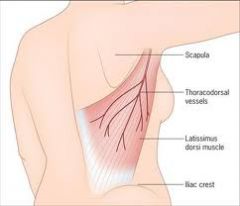
Based on the thoracodorsal artery
|
|
|
Regional Flaps - Latissimus Dorsi Flap
What are the disadvantages of this flap? |
Need for decubitus positioning
Unreliability Frequent donor site wound dehiscence |
|
|
Regional Flaps - SCM flap
What are the applications of this flap? |
Superiorly based flap used to buttress oral and pharyngeal suture lines
- rotation is limited by spinal accessory nerve's entry into anterior border of muscle - contraindicated in high-stage neck dissections |
|
|
Regional Flaps - SCM Flap
Which artery is the flap based on? |
Based on the occipital artery
|
|
|
Free Microvascular Flaps
If a patient does not have recipient vessels within the reach of the defect, what are the options? |
Consent for vein grafts, or alteranatively, an arteriovenous fistula may be formed in the neck using a saphenous vein graft before the planned microvascular reconstruction.
|
|
|
Free Microvascular Flaps
Most flap failures occur within ___ hours of revascularization |
72 hours
|
|
|
Free Microvascular Flaps
What is the basis of using posoperative aspirin, LMWH or heparin after revascularization? |
Vessel wall dissection, disruption and suture puncture results in endothelial discontinuity and exposure of thrombogenic subendothelial collagen
|
|
|
Free Microvascular Flaps
What basic vitals must be maintained to allow optimal graft perfusion? |
Normal blood pressure and euvolemia
Normothermia (will minimize peripheral vasoconstriction and sympathenic outflow) |
|
|
Free Microvascular Flaps - Temporoparietal Fascia Free flap
What are the applications for this flap? |
1) Reconstruction of oral mucosal defects, usually with a skin graft
2) Reconstruction of facial contour defects 3) Reconstruction of difficult orbital and temporal bone defects 4) Reconstruction of hemilaryngectomy defects A harvest dimension of 17x14 cm can be achieved. May harvest a split calvarial bone with this flap to create a composite flap. |
|
|
Free Microvascular Flaps - Temporoparietal Fascia Free flap
What are the disadvantages this flap? |
Small caliber donor vessels
Vein is superficial to the fascia, making it vulnerable during flap harvest Risk of injury to the frontal branch of the facial nerve Risk of alopecia |
|
|
Free Microvascular Flaps - Radial Forearm Free Flap
What are the applications of this flap? |
Tongue
Floor of mouth Palatal reconstruction Total lower lip reconstruction with suspension using palmaris longus tendon Pharyngoesophageal reconstruction Cheek Nasal reconstruction Skull base reconstruction |
|
|
Free Microvascular Flaps - Radial Forearm Free Flap
Which vessels and nerves are provided by this flap? |
Radial vessels
Fasciocutaneous vessels Sensory capabilities provided by the latearl and medial antebrachial cutaneous nerves |
|
|
Free Microvascular Flaps - Lateral Arm Free Flap
What are the applications of this flap? |
Tongue reconstruction
Pharyngoesophageal reconstruction Cheek reconstruction |
|
|
Free Microvascular Flaps - Lateral Arm Free Flap
Which vessels and nerves are provided by this flap? |
Posterior branches of the radial colateral vessels
Sensory provided by the posterior cutaneous nerve of the forearm and the posterior cutaneous nerve of the arm |
|
|
Free Microvascular Flaps - Lateral Arm Free Flap
What are the disadvantages of this flap? |
Cosmetic deformity at donor site
Pedicle dissection is more difficult than that of the forearm Pedicle is shorter than that of the forearm flap Lateral arm numbness Elbow pain due to release of the triceps from the humerus |

